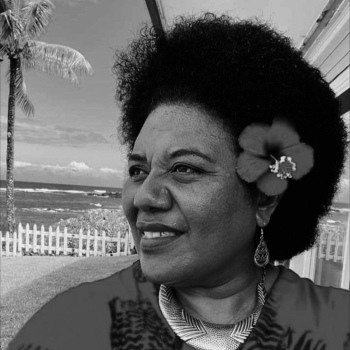Tarisi Sorovi-Vunidilo grew up in Fiji surrounded by stories, tales told by her parents to their seven children each night. They heard about family and place and flora and fauna, and the deep connections they had to specific lands and traditions. The stories told them who they were.
Not all families are raised with stories, as she later learned. Many within Fiji weren’t connecting the past with the present and future, and many who emigrated elsewhere in the world were losing their connection to the islands that had shaped their identities for generations.
Tarisi is bridging those gaps where she can by teaching children, wherever they are, the Fijian language online — giving them words but also linking the words to geography and culture, to heritage and ancestors. As Dr. T, she has the children place pins on a map of the Pacific Island nation to show where their families come from, the pins creating a physical connection to their roots. She shows them images from museum collections. She adds context and tradition to the words she is teaching them. Bilibili: a raft made of bamboo shafts; from a tree that grows on land your family comes from.

In today’s complex world, she says, where Fijians are scattered around the globe far from their culture and sometimes facing isolation or discrimination, where children may be bullied for being different, a strong sense of identity is empowering. It tells children how special they are.
So it’s just this whole package of who you are that I believe these children should know because there’s so much richness in it.
“When we were little we were told and taught where we come from: your father’s village, and where your mum is from. And you have to know the name of the tribe, you have to know the things associated with the tribes, because it all connects back to land ownership.
“Land of course is a physical entity of your identity, you know who you are. But land is also a spiritual connection to your past. So these storytelling sessions that I do are trying to connect the two, to remind the parents and remind the children that you have land back home, and it has a name. And you need to know your tree, we also say that in the tree there’s a bird that belongs to you, if you’re close to the ocean there’s a fish that is your identity. So it’s just this whole package of who you are that I believe these children should know because there’s so much richness in it.
“Imagine the children whose totems are turtles. The turtle is such a beautiful creature, but imagine if that is your animal that you have to look after; but not only that you look after the turtle, but the turtle looks after you.” Her voice quietens to a hush. “So it’s a symbiotic relationship that is there. It’s a beautiful thing.”
The non-physical connection is important, not just because people may be far from the Pacific region but because the lands themselves may not survive natural disasters and now climate change.
These collections are an important way of keeping the stories alive, she says, and the institutions must meet the responsibility of digitizing their collections, to make the heritage accessible to the people who created it.
“If there’s anything whatsoever like sea-level rise, climate change, geological catastrophe that can happen and erase your land, your story should remain.”
Tarisi remembers visiting museums as a child on school outings and how seeing the items there connected back to the storytelling she heard at home. These collections are an important way of keeping the stories alive, she says, and the institutions must meet the responsibility of digitizing their collections, to make the heritage accessible to the people who created it. This includes correcting and adding to the information on each item whenever possible.
She was involved herself in one special example. She spent a year at the Auckland War Memorial Museum in New Zealand going through a treasure trove of Fijian items that, in the colonial way of most museum collections, were categorized with an English name and the briefest of descriptions. She invited Fijian experts in pottery, in weaving, and in other cultural fields to descend into the museum’s underground vault and examine items so that not just Fijian names but Fijian knowledge could be added to the museum’s information. The expanded, corrected, decolonized information is now shared digitally with the world.
She took photos on her phone as they worked, posting some on social media, and Fijians elsewhere started sharing stories and posting their own pictures.
“The memories!” she exclaims. She said to the museum, “You have awoken something that was there for a long time.”
She is still impressed with how open the museum’s curators were as they worked. This is a world where items are touched only by people wearing white gloves. Preservation is the highest responsibility. But imagine this: An older Fijian woman, invited for her expertise in weaving, picks up a fan from the collection. She begins to dance and sing. The iri ni meke, the dance fan, comes to life for the first time in decades.
Tarisi catches the unexpected moment on her phone. The information the woman adds is included in the museum’s metadata.
It’s there for Fijian children around the world to find when they go online to research, perhaps, the word iri. Fan. They can see the past and bring it into their present and future. They can say, I know who I am. I have all my ancestors with me.
